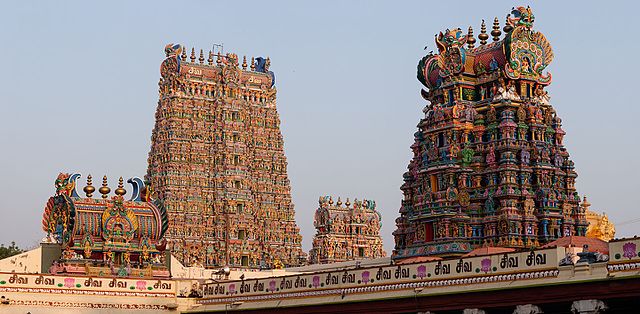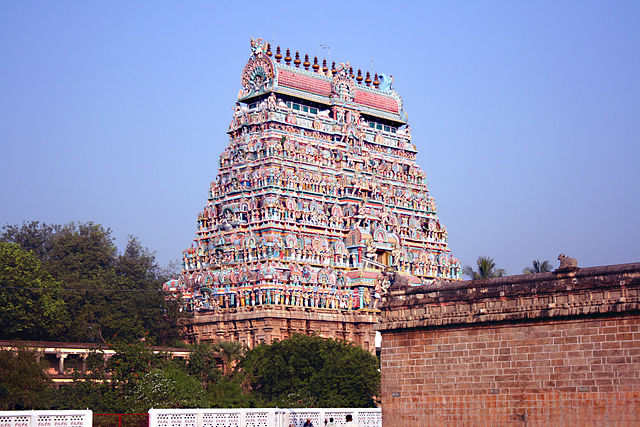
| PANDYA DYNASTY Overview :
Pandyas, also known as the Pandyas of Madurai, was a dynasty of south India. The Pandyas ruled extensive territories, at times including the large portions of present-day south India and Sri Lanka (through collateral branches subject to Madurai). They fought Mahabharat War in Pandav's side
Jat
clans :
History
:
Karna Parv in Mahabharat narrates the appointment of the wise king of Madra as (Karna's) charioteer. Then the history of the fall of the Asur Tripura. Then the application to each other by Karna and Shalya of harsh words on their setting out for the field, then the story of the swan and the crow recited in insulting allusion: then the death of Pandya at the hands of the high-souled Aswatthaman; then the death of Dandsen; then that of Darda; then Yudhishthir's imminent risk in single combat with Karna in the presence of all the warriors; then the mutual wrath of Yudhishthir and Arjun; then Krishna's pacification of Arjun. In this Parv, Bhim, in fulfilment of his vow, having ripped open Dushashan's chest in battle drank the blood of his heart. Then Arjun slew the great Karna in single combat.
The Hathigumph inscription of king Kharvel at Bhuvneshwar mentions about a Pandya king in Line 13 as under:
Mention
by Pliny :
Another port, and a much more convenient one, is that which lies in the territory of the people called Neacyndi, Barace by name. Here king Pandion used to reign, dwelling at a considerable distance from the mart in the interior, at a city known as Modiera. The district from which pepper is carried down to Barace in boats hollowed out of a single tree, 34 is known as Cottonara.
None of these names of nations, ports, and cities are to be found in any of the former writers, from which circumstance it would appear that the localities have since changed their names. Travellers set sail from India on their return to Europe, at the beginning of the Egyptian month Tybis, which is our December, or at all events before the sixth day of the Egyptian month Mechir, the same as our ides of January: if they do this, they can go and return in the same year. They set sail from India with a south-east wind, and upon entering the Red Sea, catch the south-west or south. We will now return to our main subject.
32 Or Favonius, the west wind, previously mentioned in the present Chapter.
33 The modern Mangalore, according to Du Bocage.
34 Or canoes.
35 The Cottiara of Ptolemy, who makes it the chief city of the Æi, a tribe who occupied the lower part of the peninsula of Hindostan. It has been supposed to be represented by the modern Calicut or Travancore. Cochin, however, appears to be the most likely.
36 Marcus observes that we may conclude that either Pliny or the author from whom he transcribed, wrote this between the years of the Christian era 48 and 51; for that the coincidence of the 6th of the month Mechir with the Ides of January, could not have taken place in any other year than those on which the first day of Thoth or the beginning of the year fell on the 11th of August, which happened in the years 48, 49, 50, and 51 of the Christian era.
Line
13 - [His Majesty] caused to erect towers with strong and beautiful
gateways at the cost of two thousand coins. [His Majesty] obtained
horses, elephants and jewels losing strange and wonderful elephants
and ships. The King of Pandya caused to be brought here (capital
Kalinga Nagri) various pearls, jewels and precious stones hundred
thousand in number.
Sabha Parv, Mahabharat / Book II Chapter 13 mentions the Kshatriyas in support of Jarasandh. Pandya is mentioned in Mahabharat (II.13.20).... And, O king of kings, Bhishmak, the mighty king of the Bhojs--the friend of Indra--the slayer of hostile heroes--who governs a fourth part of the world, who by his learning conquered the Pandyas and the Krathakaishikas, whose brother the brave Akriti was like Ram, the son of Jamdagni, hath become a servitor to the king of Magadh.
Sabha Parv, Mahabharat / Book II Chapter 28 mentions Sahdev's march towards south: kings and tribes defeated. Pandya is mentioned in Mahabharat (II.28.10) / (2-32-17b). .... ....After Avanti, the hero (Sahdev) marched towards the town of Bhojkat and there, a fierce encounter took place between him and the king of that city for two whole days. But the son of Madri (Sahdev), vanquishing the invincible Bhismak, then defeated in battle the king of Koshal and the ruler of the territories lying on the banks of the Venwa, as also the Kantarkas and the kings of the eastern Koshals. The hero (Sahdev) then defeating both the Natkeyas and the Herambaks in battle, and subjugating the country of Marudh, reduced Ramyagram by sheer strength. And the son of Pandu then vanquished the mighty monarchs of the Nachins and the Arbuks and the various forest king of that part of the country. Endued with great strength the hero then reduced to subjection king Atavika. And defeating in battle the Pulinds, the hero then marched southward. And the younger brother of Nakul then fought for one whole day with the king of Pandya.
Sabha Parv, Mahabharat / Book II Chapter 28 mentions Sahdev's march towards south: kings and tribes defeated. Pandya is mentioned in Mahabharat (II.28.48). ....The hero (Sahdev) brought under his subjection and exacted tributes from the Pandyas and the Dravids along with the Udrakerals and the Andhras and the Talvans, the Kalings and the Ushtrakarniks, and also the delightful city of Atavi (Rom) and that of the Yavans.
Van Parv, Mahabharat / Book III Chapter 86 mentions the sacred tirths of the south. Pandya is mentioned in Mahabharat (III.86.10). ....O Bharat! And, O son of Kunti, in that spot is the tirth called Ashok (III.86.10) abounding in woody retreats of ascetics. And, O Yudhishthir, in the country of the Pandyas (III.86.10) are the tirths named Agastya (III.86.10) and Varun (III.86.10).
Van Parv, Mahabharat / Book III Chapter 255 describes Karna's victory march and countries subjugated. Pandya is mentioned in Mahabharat (3-255-14a). .... Having met with Rukmi (3-255-14a), Karna (3-255-14a), repaired to Pandya (3-255-14a) and the mountain, Shri (Shrishail) (3-255-14a). And by fighting, he made Keval (3-255-15a), king Nil (3-255-15a), Venudari's (3-255-15b) son, and other best of kings living in the southern direction pay tribute.
Bhishma Parv, Mahabharat / Book VI Chapter 46 mentions Krishna, Yudhisthir and his brothers looking for arrangements of the war. Pandya is mentioned in Mahabharat (VI.46.50). ....Balhikas, Tittiras, and Cholas Pandya.
Pandya
:
Ptolemy (around 150 AD) has written Pandudesh as ' Panduoyi ' and has described it as belonging to Punjab. It is possible that there was some relation between the 'Pandya country' of the far south and the 'Pandudesh' of the north. It is known from ancient literature that South India had some connection with Shurasen or Mathura, which may be the 'Pandudesh ' mentioned by Ptolemy as the birthplace of Sri Krishna, the beloved friend of the Pandavs, as also indicated by the account of Megasthenes. Just as the capital of Shurasen country was Mathura, similarly the capital of 'Pandya country' was also 'Madhura' or present day 'Madura' or 'Madurai'. possibly the answer People must have gone and settled in South India later.
Katyayan has told the origin of the word Pandya from Pandu. In Ashoka's 13th edict, 'Pandya' is considered along with Chola and Satyaput in the neighboring countries of the Mauryan Empire. In Raghuvansh 6, 60-61-62-63-64-65, Kalidas has given a beautiful description of Pandyaraj and his country in the context of Indumati Swayamvar, a part of which is- 'Pandyos Yamansarpitalambahar: Kliptaammaragoharichandnen, Abhati Balatparktasanu: Sanirjharodgar Dwadiraj:. Tambulvalli Paridhpugaswelalalingintchandanasu, Tamalapatrastranasurantum Prasid Shasvan Malayasthalishu.
These verses describe the sandalwood, tambul, ella (cardamom) and tamal trees and creepers of the Padya country and the location of the Malay mountain is described as this country. In Raghuvansh 6,65, Pandyaraj is called 'Indivar Syamatanu' which is the natural body color of the Indians of the far south. According to Sri Raychaudhuri, the ancient Pandya country included the present Madura, Ramnad and Tinnevali districts and the southern part of Kerala and had its capital at Korkai and Madura (South Madhura). (Raychaudhuri, Political History of Ancient India, p.270) (D. Korkai and Madura).
Pandya
dynasty :
Dalip Singh Ahlawat writes :
Vidarbh country was ruled by Yaduvanshi Shashibindu. It was Chakravarti Samrat who happened in the seventh generation from Yadu in the branch of Yadu's son Karokshatri. These dynasties and territories are mentioned in Ramayan and Mahabharat which are as follows -
Sugriv ordered the monkey army to go to the countries mentioned above to search for Sita.
•
In the east direction - Videh (Va. Ra. Kishkindha Kand Sarg 40).
North
Mathura :
Distribution
in Rajasthan :
Bhanwati.
Pandya Dynasty in detail :
The Pandya dynasty at its greatest extent in 1290 CE under Marvarman Sundar Pandyan I.
The Pandya dynasty, also referred to as the Pandyas of Madurai, was an ancient Tamil dynasty of South India, and among the three great kingdoms of Tamilakam, the other two being the Cholas and the Cheras. Existing since at least the 4th to 3rd centuries BCE, the dynasty passed through two periods of imperial dominance, the 6th to 10th centuries CE, and under the 'Later Pandyas' (13th to 14th centuries CE). The Pandyas ruled extensive territories, at times including regions of present-day South India and northern Sri Lanka through vassal states subject to Madurai.
The rulers of the three Tamil dynasties were referred to as the "three crowned rulers (the mu-ventar) of the Tamil country". The origin and the timeline of the Pandya dynasty are difficult to establish. The early Pandya chieftains ruled their country (Pandya Nadu) from the ancient period, which included the inland city of Madurai and the southern port of Korkai. The Pandyas are celebrated in the earliest available Tamil poetry (Sangam literature"). Graeco-Roman accounts (as early as 4th century BCE), the edicts of Maurya emperor Ashok, coins with legends in Tamil-Brahmi script, and Tamil-Brahmi inscriptions suggest the continuity of the Pandya dynasty from the 3rd century BCE to the early centuries CE. The early historic Pandyas faded into obscurity upon the rise of the Kalabhra dynasty in south India.
From the 6th century to the 9th century CE, the Chalukyas of Badami or Rashtrakutas of the Deccan, the Pallavs of Kanchi, and Pandyas of Madurai dominated the politics of south India. The Pandyas often ruled or invaded the fertile estuary of Kaveri (the Chola country), the ancient Chera country (Kongu and central Kerala) and Venadu (southern Kerala), the Pallav country and Sri Lanka. The Pandyas fell into decline with the rise of the Cholas of Thanjavur in the 9th century and were in constant conflict with the latter. The Pandyas allied themselves with the Sinhalese and the Cheras in harassing the Chola Empire until it found an opportunity for reviving its frontiers during the late 13th century.
The
Pandyas entered their golden age under Maravarman I and Jatavarman
Sundara Pandya I (13th century). Some early efforts by Maravarman
I to expand into the ancient Chola country were effectively checked
by the Hoysalas. Jatavarman I (c. 1251) successfully expanded the
kingdom into the Telugu country (as far north as Nellore), south
Kerala, and conquered northern Sri Lanka. The city of Kanchi became
a secondary capital of the Pandyas.The Hoysalas, in general, were
confined to Mysore Plateau and even king Somesvara was killed in
a battle with Pandyas. Marvarman Kulshekhar I (1268) defeated an
alliance of the Hoysalas and the Cholas (1279) and invaded Sri Lanka.
According to tradition, the legendary Sangams ("the Academies") were held in Madurai under the patronage of the Pandyas, and some of the Pandya rulers claimed to be poets themselves. Pandya Nadu was home to a number of renowned temples, including the Meenakshi Temple in Madurai. The revival of the Pandya power by Kadungon (7th century CE) coincided with the prominence of the Shaivite nayanars and the Vaishnavite alvars. It is known that the Pandya rulers followed Jainism for a short period of time in history.
Etymology
and origin legends :
According to the ancient Tamil legends, the three brothers Cheran, Cholan and Pandyan ruled in common at the southern city of Korkai. While Pandya remained at home, his two brothers Cheran and Cholan after a separation founded their own kingdoms in north and west. Epic poem Silappatikaram mentions that the emblem of the Pandyas was that of a fish. Indian traditions such as the Great Epics and the Purans often associate southern India with Sage Agastya (who had his ashram in the south). Agastya appears prominently in medieval Tamil literature also.
Folklores attributes Alli Rani (meaning "the queen Alli") as one of the early historic rulers of the Pandyas. She is attributed as an "amazonian queen" whose servants were men and administrative officials and army were women. She is thought of ruling the whole western and northern coast of Sri Lanka from her capital Kudiramalai, where remains of what is thought of as her fort are found. She is sometimes seen as an incarnation of the Pandya associated gods, Meenakshi and Kannagi.
Chandra-vansh
:
Sources
of Pandya history :
Archaeological sources :
Mangulam inscription (3rd and 2nd centuries BCE) Pandyas are also mentioned in the inscriptions of Maurya emperor Ashok (3rd century BCE). In his inscriptions (2nd and 13th Major Rock Edict) Ashok refers to the peoples of south India – the Cholas, Cheras, Pandyas and Satiyaputras. These polities, although not part of the Maurya empire, were on friendly terms with Ashok:
The conquest by dharma has been won here, on the borders, and even six hundred yojans (5,400–9,600 km) away, where the Greek king Antiochos rules, beyond there where the four kings named Ptolemy, Antigonos, Magas and Alexander rule, likewise in the south among the Cholas, the Pandyas, and as far as Tamraparni river.
The earliest Pandya to be found in epigraph is Nedunjeliyan, figuring in the Tamil-Brahmi Mangulam inscription (near Madurai) assigned to 3rd and 2nd centuries BCE. The record documents a gift of rock-cut beds, to a Jain ascetic. It is assumed that the people found in the Mangulam inscription, Nedunjeliyan, Kadalan, and Izhanchadikan predates rulers such as Talaiyanganam Nedunjelyan and Palyaga-salai Mudukudimi Peruvaludi.
Kharavela, the Kaling king who ruled during c. 1st century BCE, in his Hathigumph inscription, claims to have destroyed an old confederacy of Tamil countries ("the tamira–desa–sanghata") which had lasted 132 years, and to have acquired a large quantity of pearls from the Pandyas.
Silver punch-marked coins with the fish symbol of the Pandyas dating from around the same time have also been found.
Early
Tamil literature :
Pandya rulers from early historic south India :
•
Koon Pandya
Beside several short poems found in the Akananuru and the Purananuru collections, there are two major works – Mathuraikkanci and Netunalvatai – which give a glimpse into the society and commercial activities in the Pandya country during the early historic period. The Purananuru and Agananuru collections contain poems sung in praise of various Pandya rulers and also poems that were claimed to be composed by the rulers themselves.
Besides the poems, king Peruvaludi is also mentioned in later copper-plate grant (8th–9th century CE). In the work Mathuraikkanci, the author Mankudi Maruthanar, refers to his patron, Talaihalanganum Nedunjeliyan, as the Lord of Korkai and the Warlord of the Southern Parathavar People. It contains a full-length description of Madurai and the Pandya country under the rule of Nedunjeliyan. In the famous battle of Talaiyalanganam (in east Tanjore), the Pandya is said to have defeated his enemies (which included the Chera and the Chola). He is also praised for his victory of Mizhalai and Mutturu, two "vel" centres along the ocean (in Pudukkottai). The Netunalvatai (in the collection of Pattupattu) by Nakkirar contains a description of king Nedunjeliyan's palace.
Foreign
sources :
• Pandyas are also mentioned by Greek author Megasthenes (4th century BCE) where he writes about south Indian kingdom being ruled by women. He described the Pandya country in Indika as "occupying the portion of India which lies southward and extends to the sea". According to his account, the kingdom had 365 villages, each of which was expected to meet the needs of the royal household for one day in the year. He described the Pandya queen at the time, Pandaia as the daughter of Hercules.
• Pliny the Elder refers to the Pandya ruler of Madurai in
general terms (first century CE).
•
The country of the Pandyas was described as Pandya Mediterranea
and Modura Regia Pandionis by Ptolemy (c. 140 CE).
Scholar John E. Hill identified Panyue as Pandya kingdom. However, others have identified it with an ancient state located in modern Burma or Assam.
•
The Chinese traveler Xuanzang mentions a kingdom further south from
Kanchipuram, a kingdom named Malakutta, identified with Madurai
described by his Buddhist friends at Kanchipuram.
Early historic Pandyas :
Vaigai River in Madurai Maurya emperor Ashok (3rd century BCE) seems to have been on friendly terms with the people of south India and Sri Lanka (the Cholas, the Pandyas, the Satiya Putras, the Kerala Putras and the Tamraparnis). There are no indications that Ashok tried to conquer the extreme south India (the Tamilakam – the Abode of the Tamils).
The three chiefly lines of the early historic south India – the Cheras, Pandyas and Cholas – were known as the mu-vendar ("the three vendars"). They traditionally based at their original headquarters in the interior Tamil Nadu (Karur, Madurai and Uraiyur respectively). The powerful chiefdoms of the three ventar dominated the political and economic life of early historic south India. The frequent conflicts between the Chera, the Chola and the Pandya are well documented in ancient (the Sangam) Tamil poetry. The Cheras, Cholas and Pandyas also controlled the ports of Muziris (Muchiri), Korkai and Kaveri respectively (for the trade with the Graeco-Roman world). The gradual shift from chiefdoms to kingdoms seems to have occurred in the following period.
Pandya coin with temple between hills and elephant (Sri Lanka ca. 1st century CE) (British Museum) The famous inscription of king Kharavel at Hathigumph (mid-first century BCE) mentions the defeat of a confederacy of the "Tramir" countries which had been a threat to Kaling. It also remembers the precious pearls brought to the capital as booty from the "Pandya" realm. The Pandya chiefdom was famous for its pearl fisheries and silk industry. Korkai and Alagankulam are believed to have been the exchange centres of the Pandyas. Korkai, a port at the mouth of the river Tambraparni, was linked to the famous pearl fisheries and Alagankulam was also developed as a port.
A number of coins attributed to early historic Pandyas are found from the region. Inscriptions, datable to c. 2nd century BCE, recording royal grants – both from royals and wealthy commoners – were also discovered from the Pandya country.
The Pandya seems to be the most prominent of the three "ventar" rulers. There are even references to a Pandya queen from 3rd century BCE representing a confederacy of the Tamil countries. Madurai, in south Tamil Nadu, was the most important cultural centre in south India as the core of the Tamil speakers. Megalithic relics such as menhirs, dolmens, urn burials, stone circles and rock-cut chambers/passages can be found in south India. Burial goods include iron objects, ivory ornaments, Black-and-Red Ware and even some Roman Imperial coins. The so-called "velir" hill chieftains are assumed to be associated with these megalithic burials.
Greek and Latin accounts (early centuries CE), coins with legends in Tamil-Brahmi script, and Tamil-Brahmi inscriptions suggest the continuity of the Pandya dynasty from the 3rd century BCE to early centuries CE. The early Pandyas, along with the Cheras and the Cholas, were eventually displaced by the Kalabhra dynasty.
Medieval
Pandyas :
Vettuvan Koil, Kalugumalai, Tuticorin. Pandya kingdom, 8th century CE
Enthroned god Vishnu, Pandya dynasty, second half of the 8th–early 9th century CE (Metropolitan Museum of Art, New York City)
Manikkavachakar, Shaiva poet-saint and minister of Pandya king Varaguna II (dated to early 12th century) Los Angeles County Museum of Art The Pandya kingdom was revived by king Kadungon (r. 590–620 CE) towards the end of the 6th century CE. In the Velvikudi inscription, a later copper-plate, Kadungon appears as the "destroyer" of the "anti-Brahmanical" Kalabhra kings. With the decline of the Kalabhra dynasty, the Pandyas grew steadily in power and territory. With the Cholas in obscurity in Uraiyur, the Tamil country was divided between the Pallavs of Kanchi and the Pandyas of Madurai.
From 6th century to 9th century CE, the Chalukyas of Badami, the Pallavs of Kanchi, and Pandyas of Madurai dominated the politics of south India. The Badami Chalukyas were eventually replaced by the Rashtrakuts in the Deccan. The Pandyas took on the growing Pallav ambitions in south India, and from time to time they also joined in alliances with the kingdoms of the Deccan Plateau (such as with the Gangas of Talakad in late 8th century CE). In the middle of the 9th century, the Pandyas had managed to advance as far as Kumbakonam (north-east of Tanjore on the Kollidam river).
Sendan (r. 654–70 CE), the third king of the Pandyas of Madurai, is known for expanding his kingdom to the Chera country (western Tamil Nadu and central Kerala). Arikesari Maravarman (r. 670–700 CE), the fourth Pandya ruler, is known for his battles against the Pallavs of Kanchi. Pallav king Narasimhavarman I (r. 630–68 CE), the famous conqueror of Badami, claimed to have defeated the Pandyas. Chalukya king Paramesvaravarman I "Vikramaditya" (r. 670–700 CE) is known to have fought battles with the Pallavs, the Gangas, and probably with the Pandyas too, on the Kaveri basin.
Kirtivarman II (r. 744/5–55 CE), the last Chalukya king, managed to lose to his southern countries as a result of his battles with the Pandyas. Pandya kings Maravarman Rajasimha I (r. 730–65 CE) and Nedunjadaiyan/Varagunavarman I (r. 765–815 CE) threatened Pallav king Nandivarman II Pallavmalla (r. 731–96 CE) who had managed to defeat the Gangas in around 760 CE. Varagunavarman I invaded the Pallav country, conquered the Kongu country (western Tamil Nadu) and Venadu (south Kerala). King Srimara Srivallabha (r. 815–62 CE) sailed to Sri Lanka, subjugated king Sena I, and sacked his capital Anuradhapura (the Panya invasion of Sri Lanka followed a period of vassalage). However, Srimara Srivallabha was soon overpowerd by Pallav king Nripatunga (r. 859–99 CE). Sena II, the king of Sri Lanka, invaded the Pandya country, sacked Madurai and chose Varagunavarman II (r. c. 862–880 CE) as the new king soon after. It is proposed that the start of the Kollam Era, the Kerala calendar, in 825 CE marked the liberation of Venadu from Pandya control.
During the rule of Dantivarman (r. 796–847 CE), the Pallav territory was reduced by the encroachment from the Pandyas from the south (and Rashtrakutas and the Telugu-Cholas from north). Pallav king Nandivarman III (r. 846–69 CE) was able to defeat the Pandyas and Telugu-Cholas (and even the Rashtrakutas) with the help of the Gangas and the emerging Cholas.
Pandya kings (6th – 10th century CE) :
Kalugumalai Jain beds, Pandya kingdom, king Jatila Parantaka Nedunjadaiyan (8th century CE) Under Chola influence (10th–13th centuries) :
Pandya country in the Chola Empire (12th century) While the Pandyas and the Rashtrakuts were busy engaging the Pallavs, with the Gangas and the Simhalas (Sri Lanka) also in the mix, the Cholas emerged from the Kaveri delta and took on the chieftains of Thanjavur (the Mutharaiyar chieftain had transferred their loyalty from the Pallav to the Pandya). The Chola king Vijayalaya conquered Thanjavur by defeating the Mutharaiyar chieftain around c. 850 CE. The Pandya control north of the Kaveri river was severely weakened by this move (and straightened the position of the Pallav ruler Nripatunga). Pandya ruler Varaguna-varman II (r. c. 862–880 CE) responded by marching into the Chola country and facing a formidable alliance of Pallav prince Aparajita, the Chola king Aditya I and the Ganga king Prithvipati I. The Pandya king suffered a crushing defeat (c. 880 CE) in a battle fought near Kumbakonam.
By c. 897 CE, Chola king Aditya I was the master of the old Pallav, Ganga and Kongu countries. It is a possibility that Aditya I conquered the Kongu country from the Pandya king Parantak Virnarayan (r. 880–900 CE). Parantak I, successor to Aditya, invaded the Pandya territories in 910 CE and captured Madurai from king Maravarman Rajasimha II (hence the title "Madurai Konda"). Rajasimha II received help from the Sri Lankan king Kassap V, still got defeated by Parantaka I in the battle of Vellur, and fled to Sri Lanka. Rajasimha then found refuge in the Chera country, leaving even his royal insignia in Sri Lanka, the home of his mother.
The Cholas were defeated by a Rashtrakut-lead confederacy in the battle of Takkolam in 949 CE. By mid-950s, the Chola kingdom had shrunk to the size of a small principality (its vassals in the extreme south had proclaimed their independence). It is a possibility that Pandya ruler Vira Pandya defeated Chola king Gandaraditya and claimed independence. Chola ruler Sundar Parantak II (r. 957–73) responded by defeating Vira Pandya I in two battles (and Chola prince Aditya II killed Vira Pandya on the second occasion). The Pandyas were assisted by Sri Lanka forces of king Mahind IV.
Chola emperor Rajaraja I (r. 985–1014 CE) is known to have attacked the Pandyas. He fought against an alliance of the Pandya, Chera and Sri Lankan kings, and defeated the Cheras and "deprived" the Pandyas of their ancient capital Madurai. Emperor Rajendra I continued to occupy the Pandya kingdom, and even appointed a series of Chola viceroys with the title "Chola Pandya" to rule from Madurai (over Pandya and Western Chera/Kerala countries). The very of beginning of Chola emperor Kulottunga's rule (r. from 1070 CE) was marked by the loss of Sri Lanka and a rebellion in the Pandya country.
The second half of the 12th century witnessed a major internal crisis in the Pandya country (between princes Parakram Pandya and Kulsekhar Pandya). The neighbouring kingdoms of Sri Lanka, under Parakrambahu I, Venadu Chera/Kerala, under the Kulasekharas, and the Cholas, under Rajadhiraj II and Kulottung III, joinined in and took sides with any of the two princes or their kins.
Pandya kings (10th century–first half of 11th century CE) :
•
Sundara Pandya I
Imperial
Pandyas (13th–14th centuries) :
An aerial view of Madurai city from Meenakshi Temple Pandya kings (13th–14th centuries CE) :
Marvarman
Sundar I :
Jatvarman Vira II's fish insignia at Koneswaram temple in Trincomalee (Eastern Province) Jatvarman Sundar I ascended the Pandya throne in 1251 CE. He led his army to the Chola country (even as far as Nellore), to Sri Lanka and to south Kerala. He was also successful in confining the Hoysala control to the Mysore Plateau (the ancient Chola country was now overrun by the Pandyas). Kanchi functioned as the second major city in the kingdom. In his conquests, Jatvarman Sundar I was assisted by number of Pandya royals such as Jatvarman Vir Pandya.
Jatvarman Sundar I subdued Rajendra II around 1258–1260 CE and made him pay tribute. The rule of the Cholas ended c. 1279 with Rajendra III. The Pandya attacked the Hoysals in the Kaveri and captured the fort of Kannanur Koppam. Hoysal king Someshvar was forced to fall back into the Mysore Plateau. The Hoysal king, pressed by enemies from north and south, "assigned" the southern half of his kingdom to his younger son Ramnath (r. 1254–1292). Someshwar was eventually killed by the Pandya in 1262 CE. Ramnath managed to recover Kannanur and hold against the Pandya power. Jatvarman Sundar I also came into conflict with the Kadav ruler Kopperunjing II. It seems that Ban (Magdai) and Kongu countries came under the Pandya rule during the wars against the Hoysals and the Kadavs. Jatvarman Sundar I also fought the Kakatiya ruler Ganapati (1199–1262). Sri Lanka was invaded by Jatvarman Sundar I in 1258 and on his behalf by his younger brother Jatvarman Vir II between 1262 and 1264 CE. The island was again invaded and defeated by Jatvarman Vir II in 1270 CE.
Marvarman
Kulshekhar I :
Decline
of Pandyas :
After the departure of the Khiljis, Vir and Sundar Pandya resumed their conflict. Sundar Pandya was defeated, and sought help from the Khiljis. With their help, he regained control of the South Arcot region by 1314. Subsequently, there were two more expeditions from the sultanate in 1314 led by Khusro Khan and in 1323 by Ulugh Khan (Muhammad bin Tughluq) under sultan Ghiyath al-Din Tughluq.
The family quarrels and the sultanate invasions shattered the Pandya empire beyond revival and coinage discoveries made imply that the Pandyas were left with the old South Arcot region. In 1323, the Jaffna kingdom declared its independence from the crumbling Pandya influence.
Tenkasi
Pandyas (14th–16th centuries) :
Although the Vijaynagar Empire and the Nayaks ruled Madurai after the 14th century, they were occasionally opposed by the Pandyas. Sometimes they have ruled Madurai. Prominent among them were Sadavarman Vikrama Pandya (1401–1422 AD) and his son, Arikesari Parakram Pandya. They had built 32 forts around Madurai. Later, when Vishwanath Nayakkar became the Madurai Mandalasuvaran, he feared of Pandya resurgence in Madurai. He divided Madurai into 72 districts, including 16 districts of those closest to the Pandyas. He gave them positions and made them separate from the Pandyas. This made Pandyas to lose Madurai forever.
Legacy
:
Bukk Rai I of Vijaynagar empire conquered the city of Madurai in c. 1370, imprisoned the sultan, released and restored Arcot's prince Sambuv Rai to the throne. Bukk Rai I appointed his son Veer Kumar Kampan as the viceroy of the Tamil region. Meanwhile, Madurai sultanate was replaced by the Nayak governors of Vijaynagar in 1378. In 1529 the Nayak governors declared independence and established Madurai Nayak dynasty.
Economy :
Ancient Silk Road trade routes Early historic :
The gopura of Nellaiappar Temple The Pandya country, located at the extreme south-western tip of South Asia, served as an important meeting point throughout the history of the India. The location was economically and geopolitically significant as a key point connecting the shipping between Southeast Asia and the Middle East. Graeco-Roman merchants frequented the ancient Tamil country, present day south India and Sri Lanka, securing contacts with the Tamil chiefdoms of the Pandya, Chola and Chera families. The western sailors also established a number of trading settlements on the harbours of the ancient Tamil region.
One of the early coins of the Pandyas showing their emblem of the Two Fishes The trade with South Asia by the Greco-Roman world flourished since the time of the Ptolemaic dynasty a few decades before the start of the Common Era and remained long after the fall of the Western Roman Empire. The contacts between south India and the Middle East continued even after the Byzantium's loss of the ports of Egypt and the Red Sea in the 7th century CE.
The early historic Pandya country was famous for its supply of pearls. The ancient port of Korkai, in present-day Thoothukudi, was the center of pearl trade. Written records from Graeco-Roman and Egyptian voyagers give details about the pearl fisheries off the Gulf of Mannar. Greek historian Megasthenes reported about the pearl fisheries, indicating that the Pandyas derived great wealth from the pearl trade. Convicts were according to the Periplus of the Erythraean Sea used as pearl divers in Korkai. The Periplus even mentions that "pearls inferior to the Indian sort are exported in great quantity from the marts of Apologas and Omana". The pearls from the Pandya country were also in demand in the kingdoms of north India. Literary references of the pearl fishing mention how the fishermen, who dive into the sea, avoid attacks from sharks, bring up the right-whorled chank and blow on the sounding shell.
Pandya
coinage :
Some of the coins had the names Sundar, Sundar Pandya or merely the letter 'Su' were etched. Some of the coins bore a boar with the legend of 'Vir-Pandya. It had been said that those coins were issued by the Pandyas and the feudatories of the Cholas but could not be attributed to any particular king. The coins of Pandyas were basically square. Those coins were etched with elephant on one side and the other side remained blank. The inscription on the silver and gold coins during the Pandyas, were in Tamil-Brahmi and the copper coins bore the Tamil legends. The coins of the Pandyas, which bore the fish symbols, were termed as 'Kodandaraman' and 'Kanchi' Valangum Perumal'. Apart from these, 'Ellamthalaiyanam' was seen on coins which had the standing king on one side and the fish on the other. 'Samarakolahalam' and 'Bhuvanekaviram' were found on the cois having a Garud, 'Konerirayan' on coins having a bull and 'Kaliyugaraman' on coins that depict a pair of feet.
Religion :
The Pandya period (c. 13th century CE) was characterised by a temple-centered elite form of Hinduism, a popular bhakti religion and an even more widespread local forms of Hinduism. The distinctions between the three were not clearly differentiated. The worship of the gods Vishnu and Shiva was generally supported by the elite. The bhakti movement emphasized the mutual intense emotional attachment between the god and the devotee.
The Pandya country was home to a number of renowned temples including Meenakshi Temple in Madurai. As some of the largest employers and landowners of the Pandya country, the temples played an important part in the Tamil economy and society. They generally also served as banks, schools, dispensaries, and poorhouses (thus performing valuable social functions). The large walled temple complexes of the Pandya country also contained several administrative offices and bazaars.
It is known that the early Pandya rulers followed Jainism while at some point they converted to Hinduism. They supported the Bhakti movement from both Shaivism and Vaishnavism of Hinduism.
Architecture :
Madurai, Tamil Nadu at dawn
Meenakshi Temple, Madurai
Natraj Temple, Chidambaram The early temple architecture phase in Tamil Nadu opens with the rock-cut cave temples.
The Tamil country is home to the 'South Indian' or 'Dravidian' style of medieval temple architecture.
•
Typical temple consists of a hall and a square sanctum (the gabhgrah)
•
Gopurs are extremely large and elaborately decorated (capped by
a barrel vault).
Source :
https://www.jatland.com/ https://en.wikipedia.org/ |
||||||||||||||||||||||||||||||||||||||||||||||||||||||||||||||||||||||||||||||||

.jpg)
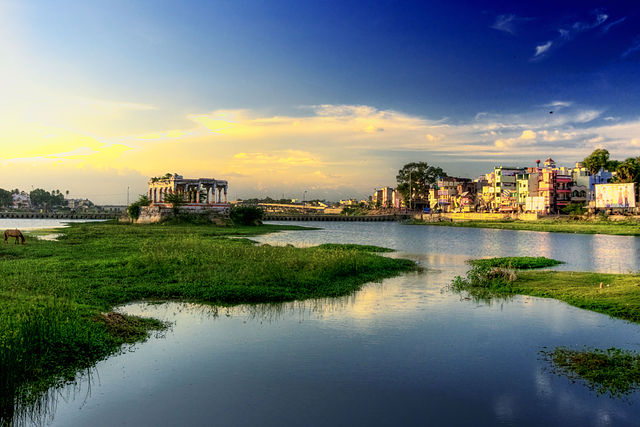
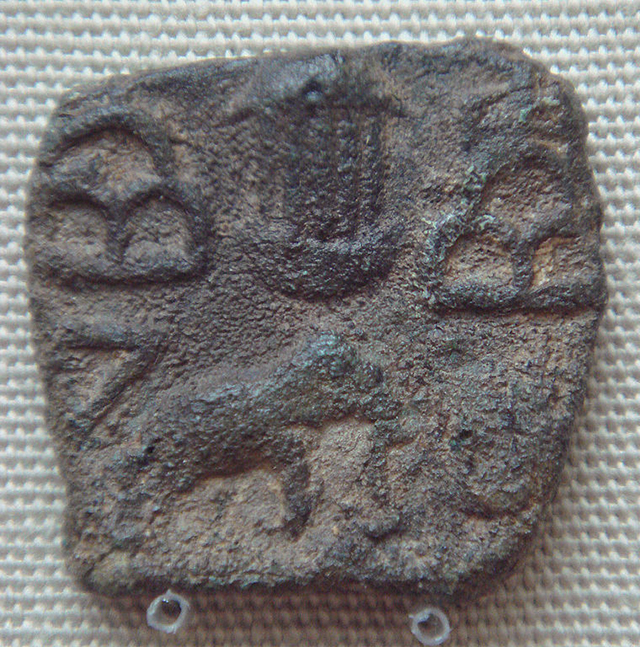

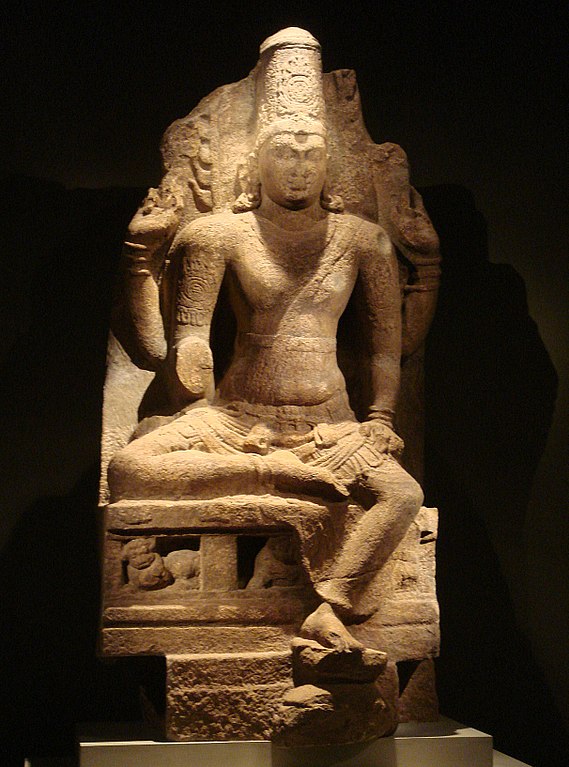
.jpg)

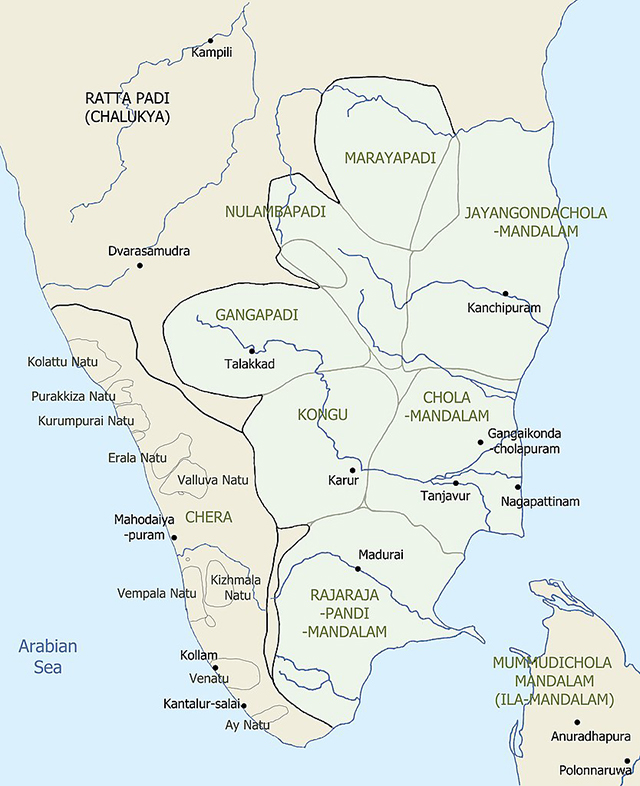

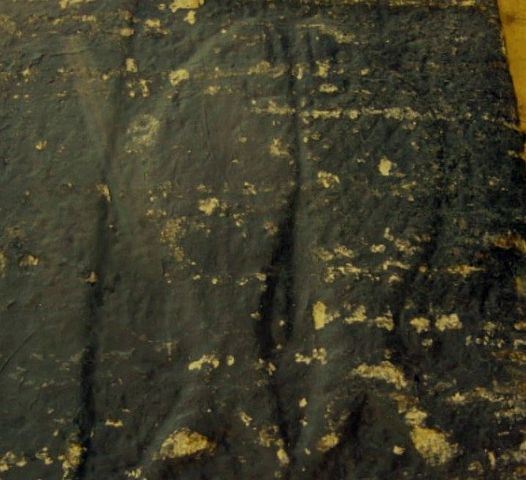
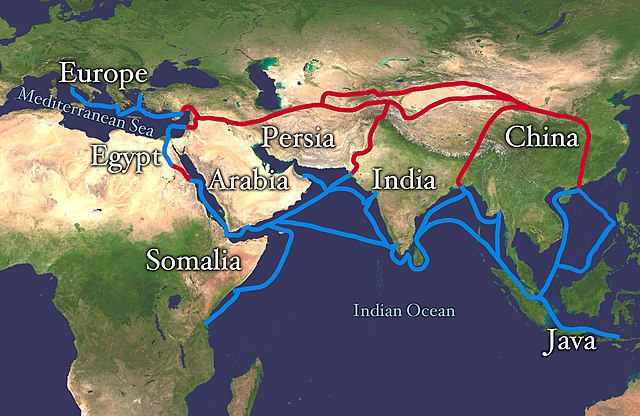
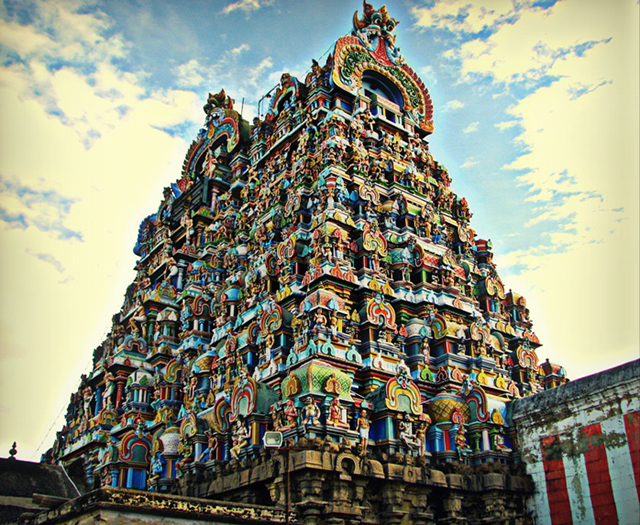
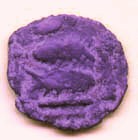
_witnessed_by_Vishnu,_Meenakshi_Temple,_Madurai_(2)_(36857653813).jpg)

